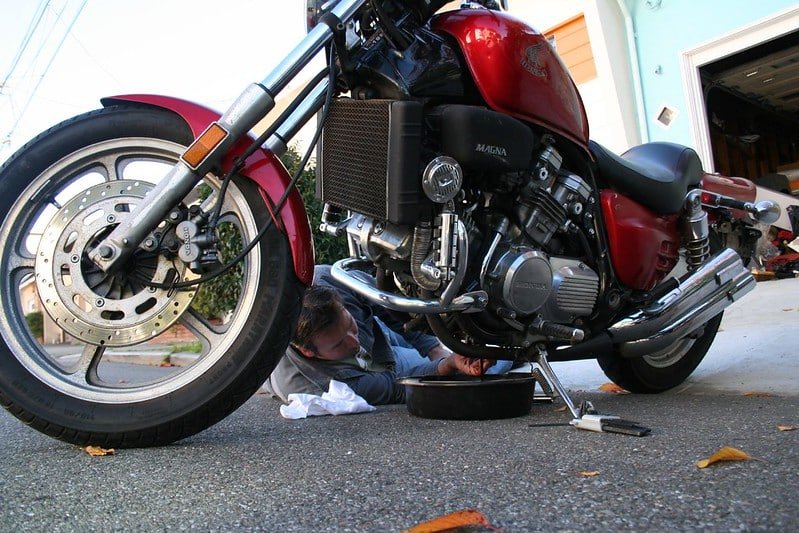Using car coolant in a motorcycle is possible on one condition! The coolant must have ethylene glycol antifreeze and be free from the traces of silicates. Such coolants can both be used in a bike and car.
Below, we have discussed in-depth details and a lot more interesting pieces of information on: Can you use car coolant in a motorcycle? Please see the details and sort out your ambiguities.
The prime purpose of a coolant is to keep the bike’s engine temperature within the safest range. The bike’s performance stays top-notch. Experts have advised regularly changing the coolant; only then it can work correctly.
If you have just owned a bike and heard people saying that car coolant can be used on a motorcycle, that is absolutely right!
Using car coolant in a motorcycle- Is it possible?
Yes, you can use a car coolant on a bike. The only thing to ensure is that it should be free from traces of silicates and has to contain ethylene glycol antifreeze.
All bike engines are constructed with aluminum alloy, and with time, coolant’s shelf life and usefulness start to deteriorate. This happens due to corrosion of the aluminum. To get rid of this problem, you must change the coolant of your bike’s engine after every two years.
Different colored coolants should not get mixed in any case. Read the information the coolant’s manufacturer provided and then make an informed decision.
Some coolants are only intended for motorcycles, and others are only for cars. However, there are some variants that you can use both in a bike and car.
To give you a quick insight, we like to tell you which is the better coolant. Whether it is ethylene glycol or propylene glycol! The main and primary anti-freeze additive used in the engines of cars, motorcycles, and other vehicles is the ”ethylene glycol”. It has anti-corrosion additives and seems to be a better option. In addition, it has superior heat transfer properties. On the other hand, propylene glycol has low toxicity levels. Some even use water as a coolant, but that should only be preferred in case of emergency.
Important points to consider before using a car coolant in a motorcycle
You must not always assume that car and motorcycle coolants are the same. A few of the car coolant reservoir has ingredients believed to be detrimental to the bike’s engine performance. Below, you can see the checklist that helps us to decide whether it is safe to use a car coolant in a bike:
Absence of silicates
The coolant you want for your bike should have ”no silicates” and ”no phosphates’’. These ingredients are harmful to your bike’s engine. Furthermore, they damage the aluminum and magnesium parts of the engine and corrode it severely. Silicates and phosphates are bad for the seals and are not eco-friendly.
Presence of ethylene glycol antifreeze
The car coolant that you want to use in the bike has to show the presence of ethylene glycol antifreeze. This respective compound is critical and crucial in keeping the engine performance stable and cooled.
Other points are:
- You must never and ever mix ethylene glycol and propylene glycol coolants. They have different colors, so it will be easy for you to identify them.
- Ethylene glycol is a poisonous substance, so handle it with care. When changing your bike’s coolant, keep the kids and pets away.
- Coolants having sulfates and phosphates form a thicker layer on the engine’s cooling system. This practice limits the process of transferring heat, and the engine overheats a lot.
- You must carefully go through the ingredients of the coolant to know whether it contains any risky ingredients.
What happens when you use the wrong coolant on your motorcycle?

You might face severe consequences for using the wrong coolant on your bike. Below, you can read out the details of what actually happens:
- The wrong coolant choice negatively impacts the performance of the bike. The engine is unable to perform at its best! Experts have repeatedly highlighted the practice of using motorcycle-specific coolants so that the bike’s performance is not impacted or ruined.
- The radiator will start to show corrosion if you mix different engine coolants or use the wrong coolant in your bike.
- The water pump, radiator hoses as well and cylinder gasket will get damaged.
- Using the wrong coolant will not properly shield the mechanical seals that are present in the water pump.
- The wrong coolant leads to overheating the bike. It causes blockage and damages the heater core at its worst.
Thus, you should only use the coolants formulated for motorcycle engines. Such picks are safe and give a worry-free riding experience. You ultimately enjoy peace of mind when using the right coolant in your vehicle.
Types of coolants for motorcycles
There are various types of coolants that are generally used in motorcycles, and they are:
Inorganic Additive technology coolant
IAT coolant uses inorganic additives, bringing a fast-acting and super-protective film to the bike’s engine. In addition, it is a traditional coolant that most bike owners prefer using. The only drawback is that the additives’ effectiveness decreases over time, so changing the IAT coolant after two years is necessary.
Organic acid technology coolant
OAT coolant is an advanced and high-end type of coolant you can use on bikes. This coolant prevents the aluminum and other metals from forming a layer of corrosion. It protects the engine surface and prolongs its lifespan.
Water-based coolant
Water-based coolants are budget-friendly to buy and can easily be mixed with water. They seem to be very efficient and effective in cooling the engine. When purchasing this coolant specifically, make sure it is made of anti-corrosive elements because that makes its formulation stronger and safer for motorcycle engines.
Water-free coolants
These coolants do not have water and do not negatively affect the engines. In other words, you no longer have to worry about the ‘’engine corrosion’’. Besides, these coolants last longer and have a higher boiling temperature. It means that they can easily withstand extreme conditions and higher engine revolutions.
How to Change Motorcycle Coolant
Changing your motorcycle’s coolant is a straightforward maintenance task, essential for optimal engine performance. Here’s a quick guide to get you started.
Materials Required:
- New coolant
- Container for old coolant
- A Funnel
- Wrench/socket set,
- Distilled water (if using concentrate)
- Rags, Hose clamps (optional)
Steps:
- Prepare: Ensure the motorcycle is cool. Position on a stand.
- Access: Remove bodywork covering the radiator or coolant reservoir.
- Drain: Place the container under the bike. Loosen drain bolt. Open the radiator cap for faster drainage. Tighten the bolt after draining.
- Flush (if needed): Fill with distilled water. Run the engine briefly. Drain. Repeat until clear.
- Refill: Using a funnel, pour new coolant into the radiator up to the fill line.
- Bleed: Start the bike, and let it idle to release trapped air. Top off coolant if the level drops.
- Check: Inspect for leaks around drain bolts and hoses.
- Reassemble: Replace bodywork. Dispose of old coolant properly.
- Test Ride: Ensure stable temperature and no leaks. Check coolant level post-ride.
FAQs
Conclusion
So, what’s the bottom line of the commonly discussed topic of using car coolant in a motorcycle? You can definitely use the car coolant if it does not have silicates and phosphates and contains ethylene glycol antifreeze. Please stay connected with us for regular updates and insightful information on car and motorcycle coolants.
